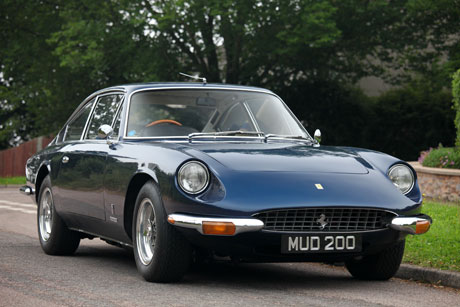SCM Analysis
Detailing
| Vehicle: | 1968 Ferrari 365 GT 2+2 |
| Number Produced: | 809 |
| Original List Price: | $19,900 |
| Tune Up Cost: | $2,500 |
| Distributor Caps: | $450 |
| Chassis Number Location: | Stamped in frame above right front spring mount |
| Engine Number Location: | Stamped on right rear of block |
| Club Info: | Ferrari Club of America PO Box 720597 Atlanta, GA 30358 |
| Website: | http://www.ferrariclubofamerica.org |
| Investment Grade: | C |
This 1968 Ferrari 365 GT 2+2 Coupe sold for $84,923, including buyer’s premium, at the Bonhams auction alongside the Goodwood Revival in Chichester, England, on September 18, 2009.
I recently overheard a friend tell someone his old 365 2+2 was his favorite of all the Ferraris he’d owned. Knowing him as both an owner and dealer of Ferraris, I thought it an odd pick so I pressed him on the choice.
He explained that he liked to drive and his 365 2+2 provided the most sensual driving experience of all his past Ferraris. He felt the interior detailing exceeded any luxury car built at the time. The large wood dash set a warm tone, with accompaniments like a binnacle full of serious gauges, exquisitely upholstered comfortable seats, plush carpeting, and a beautiful headliner. An elegant wood steering wheel with engraved spokes (a Euro-only option) complemented the dash, and even the vent windows were electric (also Euro-only).
The most sensual Ferrari driving experience
He described the enjoyment of the multi-step starting procedure. A flip of the master switch sends current to the ignition. Flipping the “A” switch wakes the “auxiliary” electric fuel pump. Turn the key a quarter turn and listen for the click-click-click to slow as the electric pump fills the Webers. Three stabs of the throttle primes a cold engine, and another twist of the key energizes the starter. Finally, the resulting whir and a roar as the engine comes to life.
My friend purchased his 365 2+2 after owning a 330 2+2 and was impressed by the differences in the cars. The standard air conditioning and power steering on the 365 were only available on the very last of the 330 2+2s, and then only as extra-cost options. Independent rear suspension improved handling on the 365s, and new Koni load leveling shocks raised the rear of the car as the trunk was loaded. Maintaining the shocks, as they frequently malfunction, has paid college tuition for many a mechanic’s children.
The driving experience completes the sensual journey. The precise shifter feel trumps that of any of transaxle cars that followed it. The responsiveness of the engine is incredible, freely revving to redline yet docile and powerful at the low end. The power steering gives just enough assist to make parking pleasurable, while not being overly sensitive on the road. The 365 is definitely not an agile sports car, but it is a superior Grand Touring vehicle.
When I first started selling Ferraris, my sales manager was something like 6′ 7″ tall. Put him in a convertible and more of his head was above the top of the windshield than behind it. Naturally, he was a fan of Ferrari’s 2+2 models and in particular the 365 2+2. This was in the early 1980s, and it was not unusual for a 365 2+2 to be on its third or fourth owner. It was also normal for one to have been driven daily and thus been nearly worn out.
Nothing cheaper than a tired 365 2+2
My boss was a sucker for a cheap Ferrari, and few were cheaper than a worn-out 365 2+2. I don’t know if all 365 2+2s were bad by then, or if he just bought the bad ones, but my memories of the cars hardly match my friend’s. I’ll allow everything he said was true-a good example was and is a wonderful drive-but too many of the ones I saw had worn paint, missing trim, rough interiors, rusted-out exhausts, and smoking engines. I cringed when he bought another one.
Since restoring a 365 2+2 costs more than they’re worth, I’m highly skeptical when I’m told of a “nice” one. I know it’s irrational, but I’m sure there’s a worn-out car lurking under the lipstick. 365 2+2s are not fragile, but too often they were rode hard and put away wet. Owners with champagne tastes and beer budgets ruined a few more. A good one can be delightful and a bad one a disaster. If you’re looking at one, look closely and know what you’re getting into.
The Bonhams auction demonstrates the disparity found between 365 2+2s. There were two examples at the sale. Our subject car, s/n 12025, matches my friend’s memory. It sounds like a well-kept example, restored as needed. It had a well-documented history, including show car service, a mention in a book, and Classiche certification. The $85k sale price sounds a bit light against U.S. prices, but it was not out of line.
The other 365 2+2 at the auction was s/n 13535. Seen previously at auction in 2003 ($18,800) and again in 2005 ($51,000), it sounds like a very average example. The auction catalog proudly noted that two of the wheels had been refurbished-a dubious statement that says a lot about the owner’s attitude toward service and adding no confidence in the quality of the car. This time, s/n 13535 sold for $63,407, a good 25% less than the subject car. You can be certain the discount is far less than it would cost to bring 13535 up to 12025’s condition. In that light, I’d call s/n 12025 well bought and s/n 13535 well sold. I suspect we’ll be seeing the latter again.
